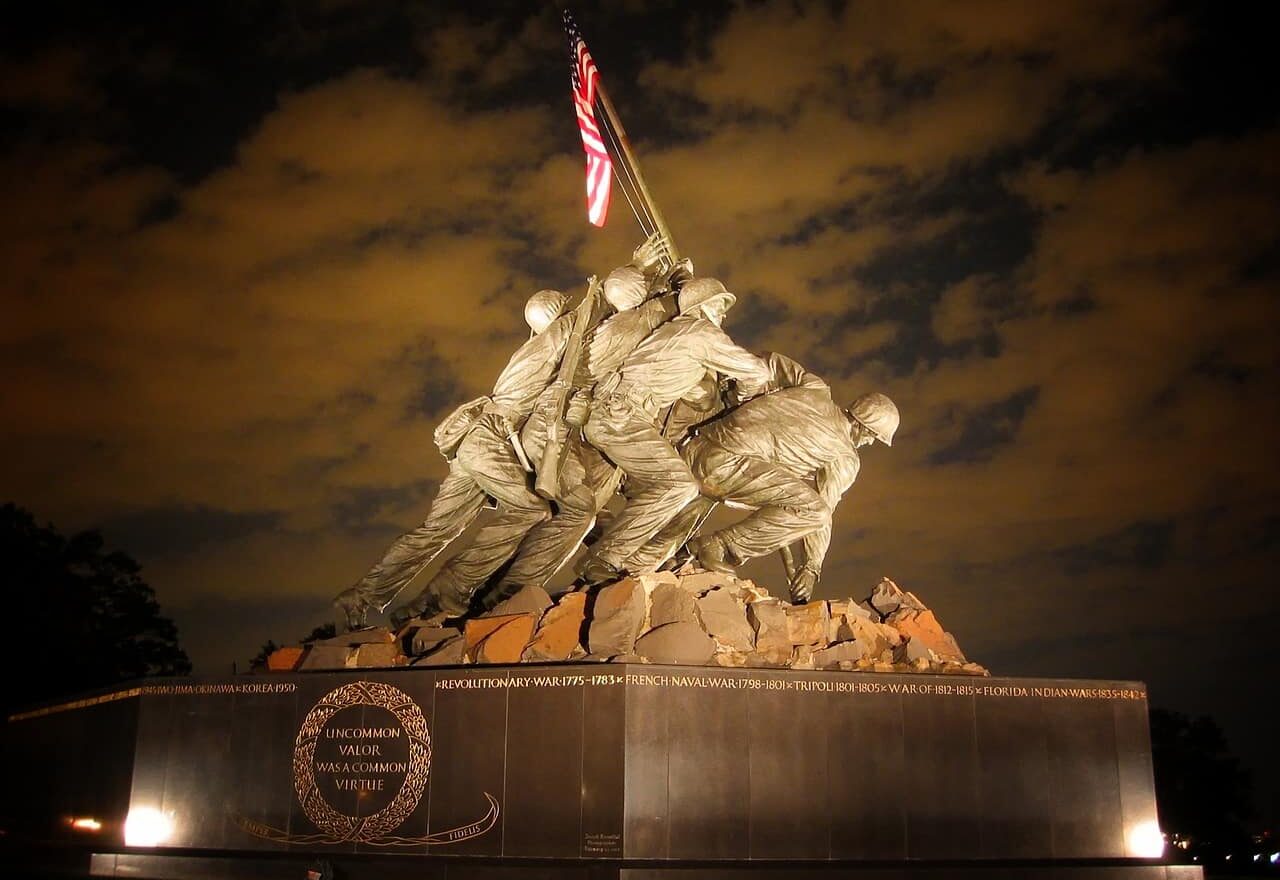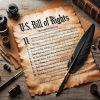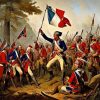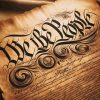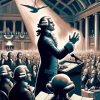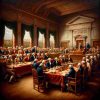Analyzing American Roles in World War II 1941-1945 a global conflict that lasted from 1939 to 1945 and involved most nations, from all-important powers like Russia and Germany, through smaller states to lesser ones, formed two military alliances for control: Allies and Axis. For the United States alone, war began on December 7, 1941, after Japanese bombs attacked Pearl Harbor; its official end took place nine months later, on September 1945, with many military campaigns, political decisions, and social changes that helped shape today’s modern society.
Analyzing American Roles in World War II 1941-1945
Before 1941, the U.S. generally pursued an isolationist policy, remaining neutral about European and Asian conflicts. However, several factors gradually nudged it closer toward involvement: aggressive totalitarian regimes such as Germany, Italy, and Japan were seen as threats to democracy everywhere. Lend-Lease programs provided military aid while remaining officially neutral – factors which ultimately forced it closer into involvement.
Pearl Harbor as a Turning Point
The Attack and Immediate Response: On December 7, 1941, Japan launched a surprise attack on Pearl Harbor, a day that President Franklin D. Roosevelt famously declared would “live in infamy.” This unprovoked aggression led to the United States formally entering World War II, as Congress declared war on Japan the following day, December 8, 1941. The attack not only marked a significant turn in global politics but also unified the American public and government in the decision to enter the war.
Public Opinion and Support for War: The Pearl Harbor attack had a profound impact on American public opinion. Prior to the attack, there was considerable debate and division within the United States regarding involvement in the war. However, the attack galvanized public support for entering the conflict, with many Americans now favoring decisive action against Japan. This shift was reflected in public opinion polls and the overwhelming support for Congress’s declaration of war against Japan, signaling a united home front ready to support the war effort.
Wider Implications and Entry into World War II: The United States’ declaration of war against Japan had broader implications, as it not only marked the official entry of the U.S. into World War II but also solidified the Allied front against Axis powers. The unity and resolve shown by the American public in the wake of Pearl Harbor were crucial in mobilizing the nation for the challenges ahead, both on the home front and in various theaters of war around the globe. This moment underscored the transition of the United States from a position of neutrality to becoming a key participant in the global conflict against Axis aggression.
U.S. Military Campaigns
In the European Theater, the United States joined forces with Britain, the Soviet Union, and other Allies to combat Nazi Germany. A pivotal moment was the D-Day invasion of Normandy on June 6, 1944, which marked a significant turning point in the war. In the Pacific Theater, the U.S. engaged in numerous naval battles and island-hopping campaigns against Japan, culminating in the strategic use of nuclear weapons on Hiroshima and Nagasaki in August 1945, leading to Japan’s surrender and the end of World War II.
- European Theater: The U.S. joined Britain, Soviet Russia, and other Allies against Nazi Germany during WWII, particularly with regard to the D-Day invasion of Normandy – considered an iconic moment during this conflict – taking place on June 6, 1944, and constituting an epic momentous turning point of World War 2.
- Pacific Theater: The war against Japan saw many naval engagements and island-hopping campaigns before finally culminating with the use of nuclear bombs on Hiroshima and Nagasaki, resulting in their surrender of Japan in 1945.
Home Front Efforts
World War I required tremendous mobilization on the home front. Industry transformed itself to support war efforts, with factories producing tanks, planes, and ships at unprecedented rates. Furthermore, World War I marked major sociological shifts, including more female participation in employment and the start of civil rights activism in this era.
Key Figures
During this period of history, several influential individuals emerged: Franklin D. Roosevelt led America during most of World War II as President before playing an integral part in creating postwar conditions and world order. General Dwight D. Eisenhower became a prominent military figure before later going on to serve his nation as President.
Admiral Chester Nimitz and General Douglas MacArthur: Two key figures in the Pacific theatre.
Technology and Innovation
World War II witnessed significant technological breakthroughs. Notable examples are:
- Radar development.
- The breaking of Enigma code encryptions.
- The Manhattan Project’s creation of a nuclear bomb.
The War’s Conclusion and Its Aftermath
World War II concluded with the unconditional surrender of Axis powers and led to America emerging as a global superpower – leading to Cold War tension between the U.S. and Soviet Russia and creating the United Nations to prevent future conflicts while rebuilding war-ravaged Europe through Marshall Plan initiatives.
The Legacy of World War II
World War II had lasting impacts, altering international politics, decolonizing numerous countries, and upending the global economic order. Human costs were enormous, while lessons from this conflict continue to influence policies and peacekeeping initiatives worldwide.
Women and Minorities During the War
World War II marked massive shifts in social roles. Women entered the workforce en masse – symbolized by Rosie the Riveter’s iconic figure – taking up previously held by men, such as factory work or military non-combat roles in noncombatant capacities. Furthermore, this conflict helped raise African American, Asian American, and other minority contributions while at the same time increasing visibility despite facing considerable discrimination during battletime.
Holocaust and Human Rights
One of the darkest chapters in World War II was Nazi Germany’s systematic genocide of six million Jews during their occupation by Nazi Germany, known as The Holocaust. This horrendous episode in history showcased racism, anti-Semitism, and totalitarianism as it played an instrumental role in shaping human rights laws such as The Genocide Convention and Universal Declaration of Human Rights ensuing later on.
Economic Repercussions
World War II had an extraordinary effect on global economies. While America enjoyed a sustained period of prosperity due to war production that ended the Great Depression, Europe and Asia experienced substantial debt accumulation as they rebuilt after being devastated in battle. After WWII ended, America rose as its primary economic power, leading to Bretton Woods Conferences with institutions such as the International Monetary Fund and World Bank being formed as primary global bodies.
The Political Landscape After War
World War II drastically transformed the post-war political environment. The United Nations was created to foster international cooperation and prevent further conflicts, and two superpowers, the United States and the Soviet Union, emerged, resulting in geopolitical tension as well as ideological disagreement known as The Cold War era. Furthermore, World War II led to colonial empires falling and independence movements popping up all around Asia, Africa, and Middle Eastern regions, initiating many freedom movements at that time.
Cultural and Social Effects
World War II had an enormous influence on culture and society. Art, literature, and film often expressed experiences from war; advances in medicine, psychology, and technology were made as a result; family structures changed drastically postwar with the baby boom generation emerging, etc.
Reflections and Education
Today, World War II remains an integral component of educational curricula worldwide, serving as a reminder of war’s costs, diplomacy’s vital role, and human rights values. Museums, memorials, and historical sites dedicated to WW2 are indispensable in remembering its lessons while keeping its memories alive.
Innovation during World War II
World War II was a hotbed of technological innovation that significantly influenced the outcome of the conflict and future technological developments. The development of radar technology was crucial for the Allies, improving the detection of incoming aircraft and ships, thus playing a pivotal role in both defence and offensive strategies. Allied cryptographers’ breaking of the Enigma code provided critical intelligence on Axis movements and plans, fundamentally shifting the war’s dynamics.
Perhaps most notably, the Manhattan Project led to the development of the atomic bomb. This groundbreaking yet controversial advancement hastened the end of the war and ushered in the nuclear age. These innovations shaped the course of World War II and laid the groundwork for technological progress in the ensuing peace
Environmental Effect of World War II
World War II had a profound environmental effect. Mass industrial production led to pollution and resource depletion; war destruction resulted in permanent changes to cities, infrastructure, and landscapes across Europe and Asia with long-term ecological ramifications; this period also raised awareness of industrial warfare’s environmental costs as it helped spark early eco-movements.
The Role of Propaganda
World War II saw all major powers use propaganda as an essential part of their war efforts to maintain morale, recruit soldiers, and mobilize efforts on all fronts. Propaganda used posters, films, and other forms of media as powerful propaganda weapons that encouraged unity and sacrifice across nations and ideologies alike. The U.S. used agencies such as Office of War Information posters that promoted unity.
Challenges of Postwar Reconstruction
Reconstructing the world after World War II was no small undertaking. Europe and Asia faced the task of rebuilding damaged cities and economies; America provided significant assistance with efforts such as its Marshall Plan program, which assisted Western European economies through reconstruction efforts. Postwar reconstruction also provided the basis for modern economic policies and international relations.
The Rise of the United Nations
Following World War II, its outcome manifested in establishing the United Nations in 1945, one of many fundamental results. Established to prevent future conflicts and foster international cooperation, its establishment marked global commitments towards diplomacy and conflict resolution.
Reflections on Leadership and Decision-Making
World War II provided ample opportunity for reflection on leadership and decision-making, from some of its finest leaders like Roosevelt and Churchill to those with destructive policies or even outright war crimes such as Hitler and Mussolini – each providing lessons about responsible leadership or its absence.
It demonstrated successes and shortcomings when considering decision-making at times of war, with leaders like Roosevelt, Churchill, Hitler, and Mussolini providing notable examples illustrating both approaches to decision-making processes versus those who took no responsibility. It made apparent the value of responsible leadership by contrast compared with their absence during that turbulent conflict era!
Conclusion
World War II (1941-1945), featuring U.S. participation, was more than an act of war; it marked an unprecedented period of transformation that dramatically altered global politics, economics, and society, shaping the latter half of this century. From lessons on international cooperation and total war’s horrors to sacrifice and resilience being shown, they remain vital lessons on human resilience when facing unprecedented adversities. As we reflect upon its lessons today, we recognize those who sacrificed while honoring the strength they showed despite incredible hardship.
FAQs(Frequently Ask Question) regarding the above topic
- What event led to the United States’ entry into World War II?
- The United States entered World War II following the Japanese attack on Pearl Harbor on December 7, 1941. This surprise military strike prompted the U.S. to declare war on Japan, marking its official entry into the global conflict.
- How did World War II impact the United States economy and the Great Depression?
- World War II had a profound impact on the United States economy, effectively ending the Great Depression. The war spurred immense industrial and military production, creating jobs, increasing wages, and leading to widespread economic growth.
- Who were America’s main allies and enemies in World War II?
- During World War II, America’s main allies, known as the “Allied Powers,” included the United Kingdom, the Soviet Union, China, and France. The primary adversaries were the “Axis Powers,” consisting of Germany, Japan, and Italy.
- How many Americans served and died in World War II, and what were their contributions?
- Over 16 million Americans served in World War II. Their contributions ranged from combat roles in the European and Pacific theaters to support roles in logistics, intelligence, and the home front’s industrial workforce. Approximately 405,000 American soldiers died during World War II. This number includes both combat-related deaths and other causes such as accidents, disease, and non-combat related incidents during the war years.
- What were the major outcomes of World War II for the United States?
- The major outcomes of World War II for the United States included emerging as a leading world superpower, significant technological and scientific advancements, the start of the Cold War, and a pivotal role in establishing the United Nations for global peacekeeping.

